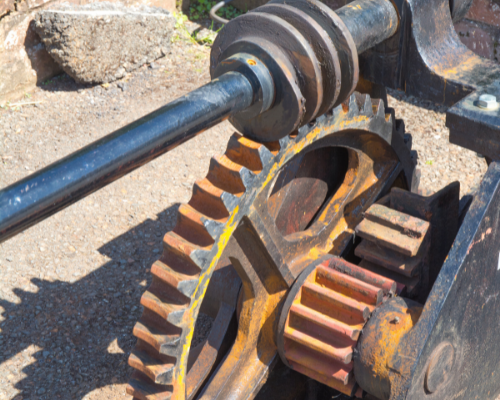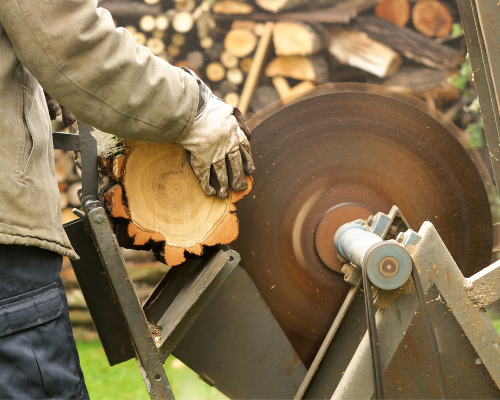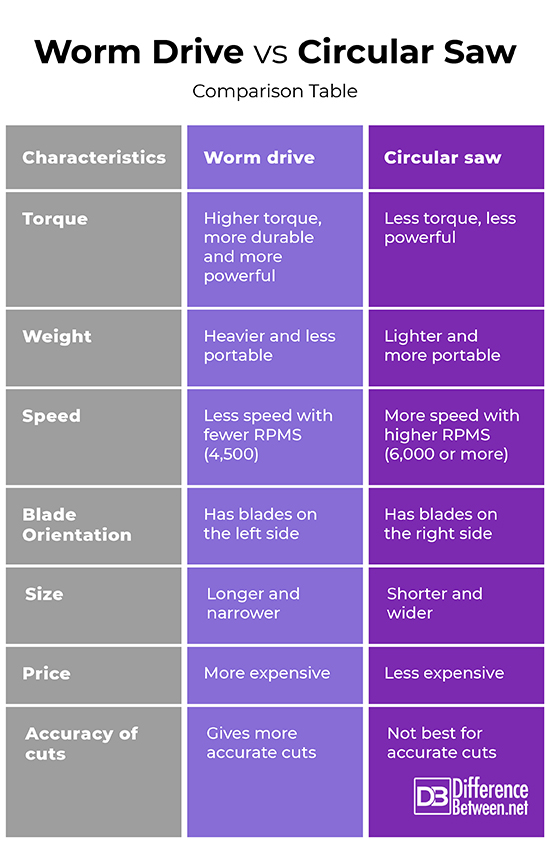Differences Between Worm Drive and Circular Saw
The right kind of saw will mean everything to anyone starting the sawyer occupation. This is because it’s the link between his effectiveness and lack thereof. There are two main types of saws, the worm drive, and the circular saw. In this article, we explore the differences between the two to help you find the right saw.

What is a Worm Drive?
A worm drive is a type of circular saw whose motor is attached at the rear end giving them a sleek profile that is useful for working in tight spaces. They are named after the spiral gear that powers the motor. This design produces excellent torque which is rotational speed and therefore greater cutting power.
Power is driven through two gears that are set 90 degrees apart. The engine produces more rotational force (torque) but fewer Rotations per Minute (RPM) of about 4,500. The positioning of the motor at the rear makes this saw longer than the regular saws.
The extra metal required for the worm drive, however, significantly increases the weight of the saw. This can lead to fatigue in the hands and shoulders on long workdays. The worm drive saw is thus heavier, more powerful, and more expensive than a regular saw. They are more efficient among professionals that need extra cutting power but not as useful to home improvement enthusiasts.
It has larger gear teeth with more loading capacity which provides more power.
Traditionally, worm drives have been blade-left while the direct drives have been blade-right.
The torque provided is enough to saw through wet lumber and concrete, making the worm drive ideal for framing and major renovation jobs.
The first to be made was Skilsaw in the mid-1920s by founder Edmond Michel.
Characteristics of Worm Drive
- Great torque
- Large cutting capacity
- Faster and more reliable cuts
- The cuts are more accurate
- The in-line motor is balanced for accurate cuts
- Heavy
- More expensive

What is a Circular Saw?
The circular saw is a type of saw whose motor is attached at its side, besides the blade. This makes the saw shorter and wider. They are also commonly known as sidewinders or direct-drive saws. Circular saws were invented in the 18th century and were commonly used in sawmills in the US in the mid-19th century. They may be handheld or mounted onto a machine. They are specially designed for the material intended to be cut. In woodwork, they are specifically made for making rip-cuts, cross-cuts, or both.
They have a less involved internal mechanical design and rely on spur gear to power the blade. It is thus a lightweight saw but produces less torque and maximum cutting power. They are lighter, more portable, and less expensive saws. The off-balance setting of the motor also makes it harder for them to make accurate cuts. For anyone who capitalizes on cost-effectiveness and portability than power and accuracy such as amateur woodworkers, they are a fine tool.
The side mounting allows the saw blade to be driven directly without extra gears. This function is known as direct drive. The saw has a good speed of up to 6,000 RPMS (because the saw works without extra gears) but less torque.
They have good ripping and cutting ability.
Characteristics of Circular Saw
- Lightweight and easily portable
- Easy to use
- Inexpensive
- Lop-sided placement of the motor is not best for accurate cuts
- Lower torque and maximum cutting capacity
- Slower cutting speed
Similarities between Worm Drive and Circular Saw
- Both saw blades are made of types of steel depending on the material they are designed to cut.
- Both have cordless versions that use batteries.
- Both can make rip-cuts and cross-cuts.
Differences between Warm Drive and Circular Saw
Torque
The worm drive has a higher torque than the circular saw. This is because it is more powerful and durable which makes it able to handle high energy. The worm drive is also designed to have larger teeth, thus enabling greater loading capacity than the circular saw.
Weight
The worm drive is heavier (from the extra metal used and the housing design) than the circular saw. The worm drive is thus less portable than the circular drive.
Speed
The worm drive has less speed with fewer Revolutions per Minute of 4,500 than the circular saw which is higher in speed, making 6,000 or more RPMs. This difference, however, balances with the torque.
Blade Orientation
Generally, the worm drive has blades on the left (blade-left) while the circular saw is blade-right. The blade-left worm drive gives left-handed users better sight-line visibility. The blade-right circular saw, on the other hand, gives better cut-line visibility to right-handed users.
Size
As a result of the positioning of the motor, the worm drive is longer and narrower than the circular drive which is shorter and wider.
Price
The worm drive is more expensive as it’s heavier and more powerful than the circular saw.
Accuracy of cuts
The worm drive is best for accurate cuts. Due to the lop-sided placement of the motor, the circular saw is not best for accurate cuts.
Worm Drive vs. Circular Saw: Comparison Table

Worm Drive vs. Circular Saw: Conclusion
The worm drive and circular saw are both good saws. If you are looking for a cost-effective and portable saw, you have it in the circular saw. If you are looking for power and accuracy, then you have it in the worm drive. Wondering which one to pick between the two? It all depends on you. Whichever choice you make, you can’t go wrong as they are both ideal.
FAQS
What is a worm drive on a circular saw?
It’s a saw with the motor attached at the rear with two gears set at 90 degrees apart to drive the motor.
What is a worm drive saw good for?
As they provide higher torque, they are best for jobs that require immense cutting power.
Are worm drive table saws better?
Yes, they are fully functional and help in keeping the weight down.
Does Dewalt make a worm drive circular saw?
Yes. Dewalt makes a worm drive circular saw
- Difference Between Profit Center and Investment Center - July 2, 2022
- Difference Between Anti-Trust and Anti-Competition - June 6, 2022
- Difference Between Stocktaking and Stock Control - June 6, 2022
Search DifferenceBetween.net :
Leave a Response
References :
[0]Roe Osborn. Framing a House. Taunton Press, 2010. https://books.google.co.ke/books?id=ON2qHeRVA54C&pg=PA38&dq=Differences+between+Worm+Drive+and+Circular+Saw&hl=en&sa=X&ved=2ahUKEwiFyuma96H0AhVqzoUKHaicA5kQ6AF6BAgIEAI#v=onepage&q=Differences%20between%20Worm%20Drive%20and%20Circular%20Saw&f=false
[1]Arnold R & Guertin M. Precision Framing. Taunton Press, 2002. https://books.google.co.ke/books?id=VRhIJ62L2jcC&pg=PT20&dq=Differences+between+Worm+Drive+and+Circular+Saw&hl=en&sa=X&ved=2ahUKEwiFyuma96H0AhVqzoUKHaicA5kQ6AF6BAgJEAI#v=onepage&q=Differences%20between%20Worm%20Drive%20and%20Circular%20Saw&f=false
[2]Building Materials Reuse Association. Introduction to Deconstruction - Textbook (Oregon State Edition). Lulu.com, 2017. https://books.google.co.ke/books?id=IEQnDwAAQBAJ&pg=PA163&dq=Differences+between+Worm+Drive+and+Circular+Saw&hl=en&sa=X&ved=2ahUKEwiFyuma96H0AhVqzoUKHaicA5kQ6AF6BAgGEAI#v=onepage&q=Differences%20between%20Worm%20Drive%20and%20Circular%20Saw&f=false
[3]Image credit: https://www.canva.com/photos/MADBCStp9K0-worm-drive/
[4]Image credit: https://www.canva.com/photos/MABDgdhDW-4-circular-saw/
